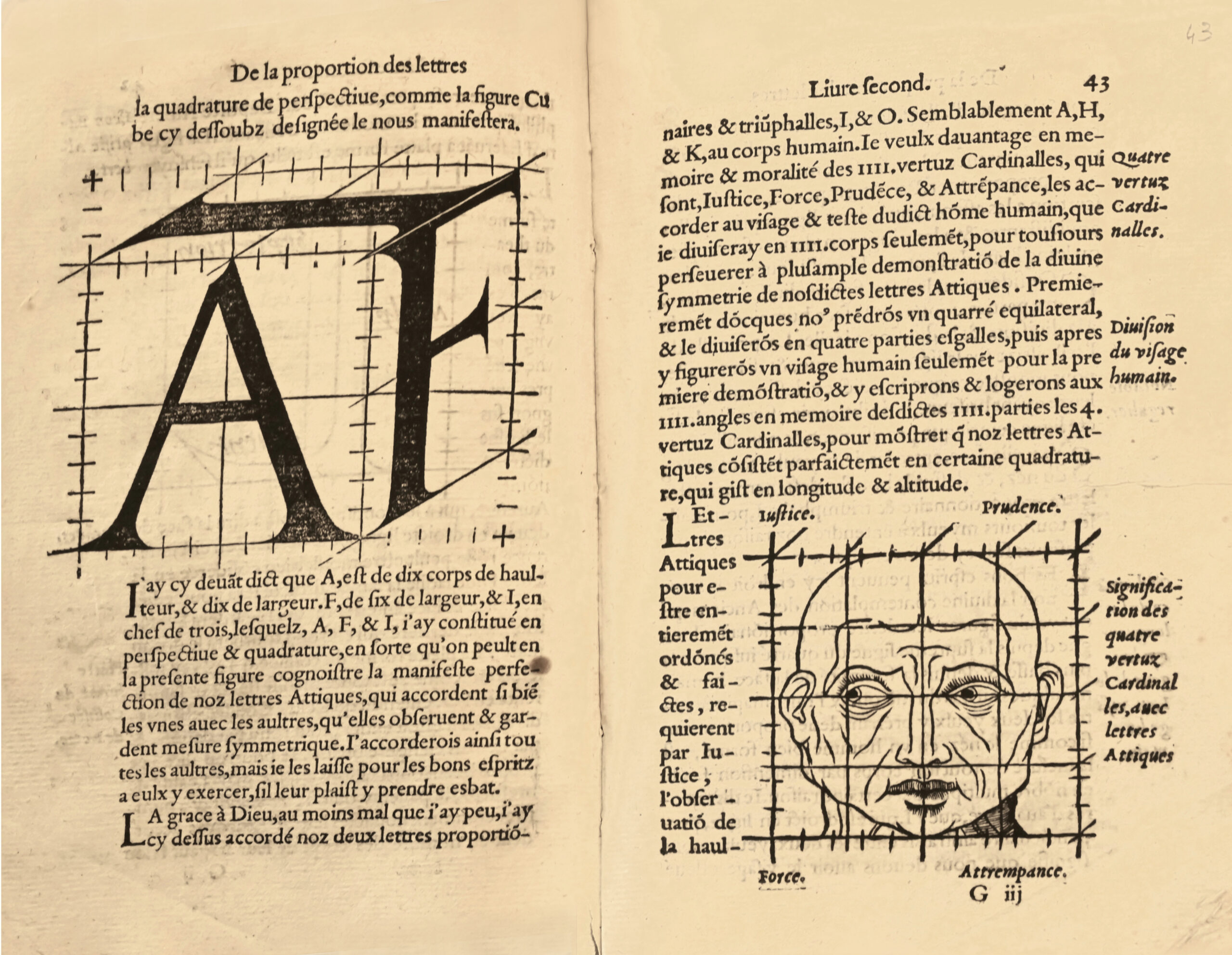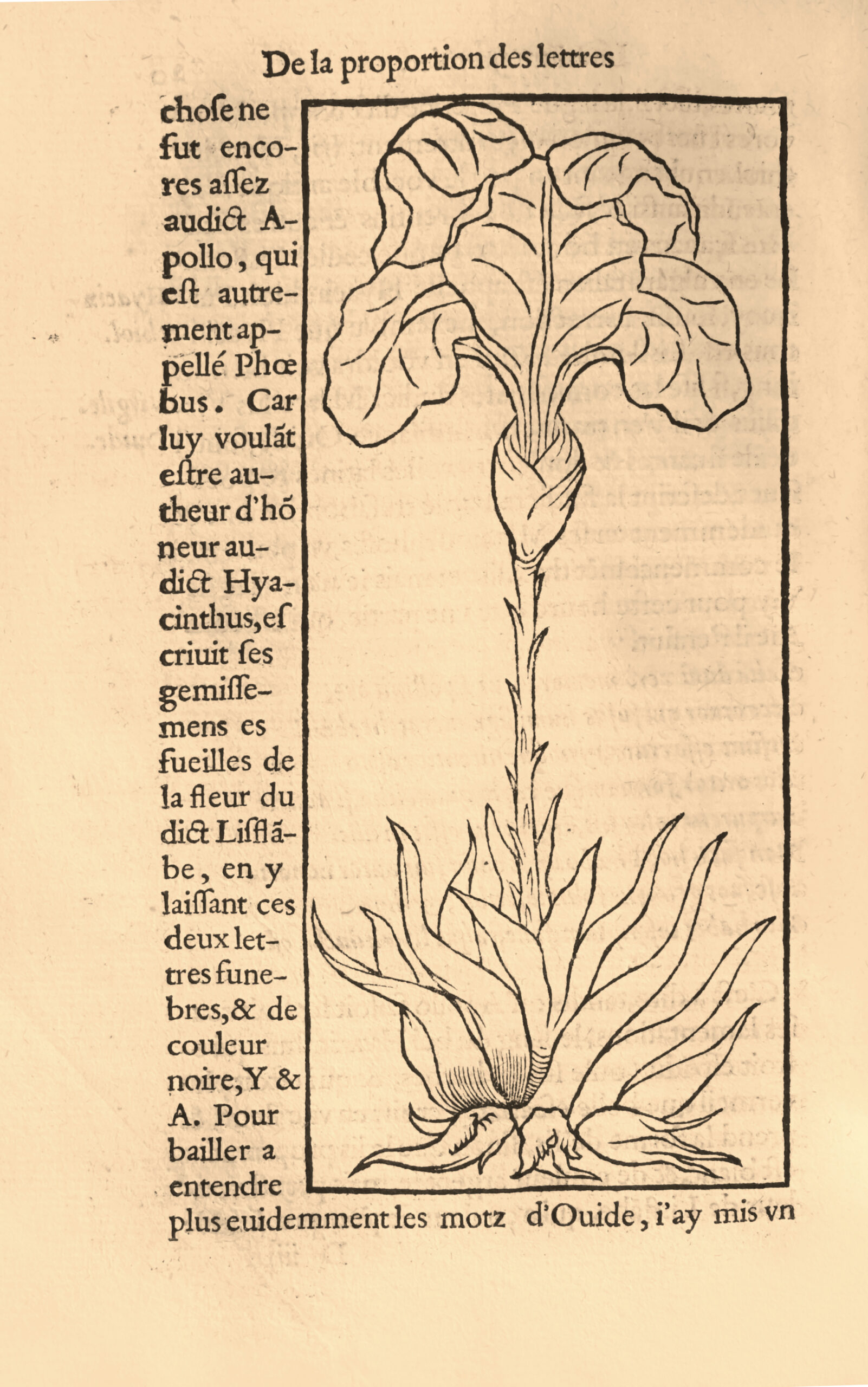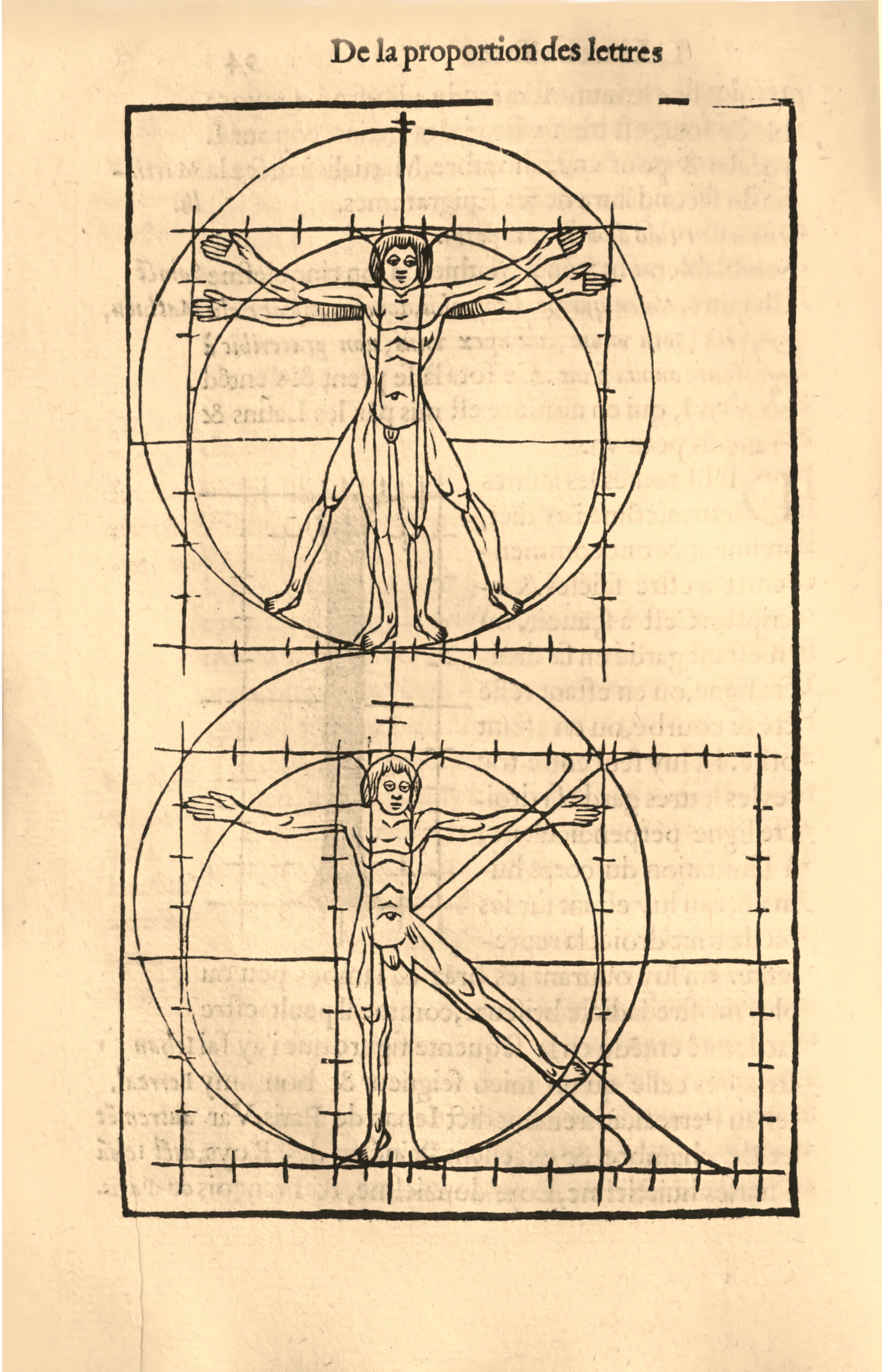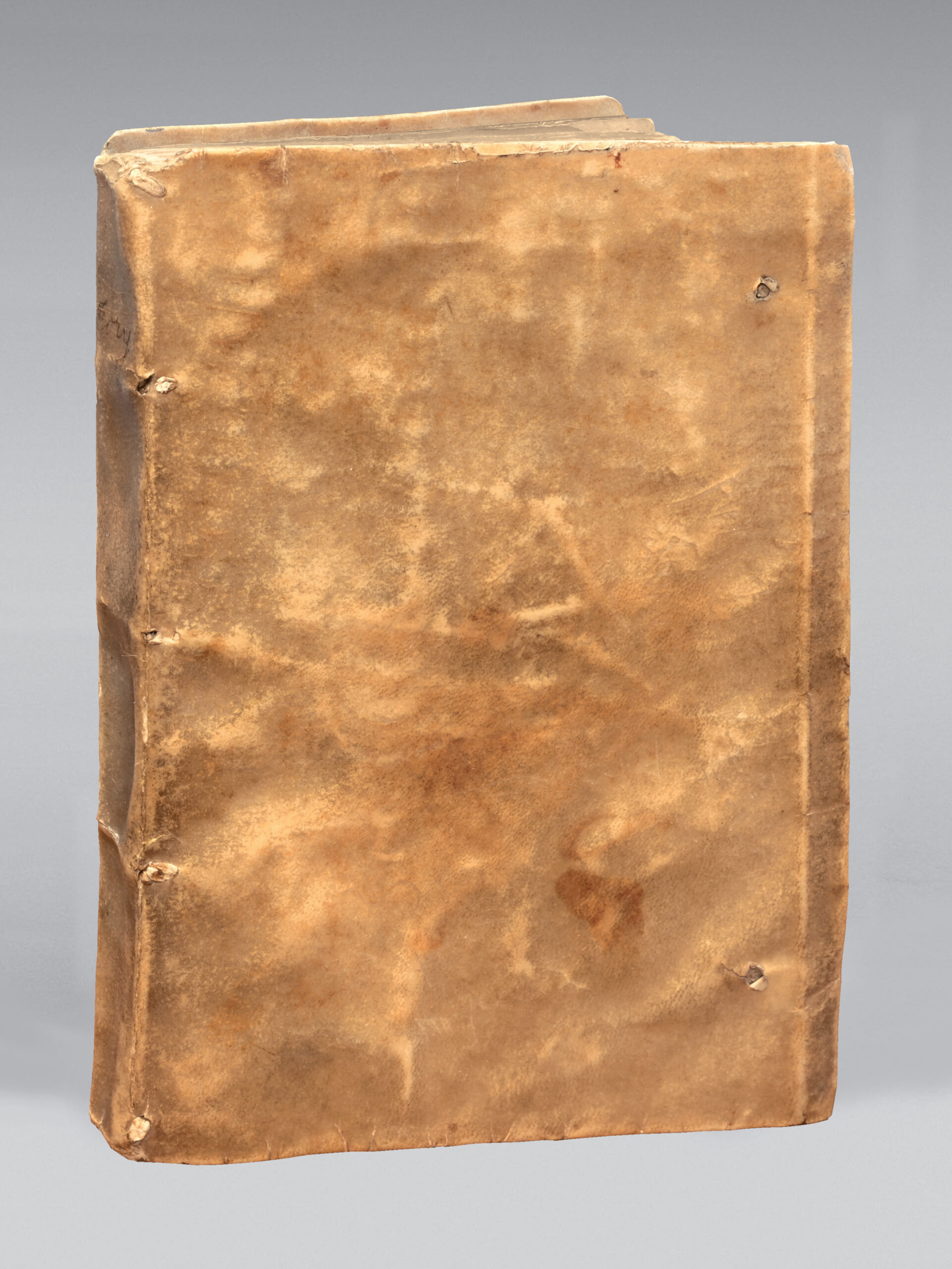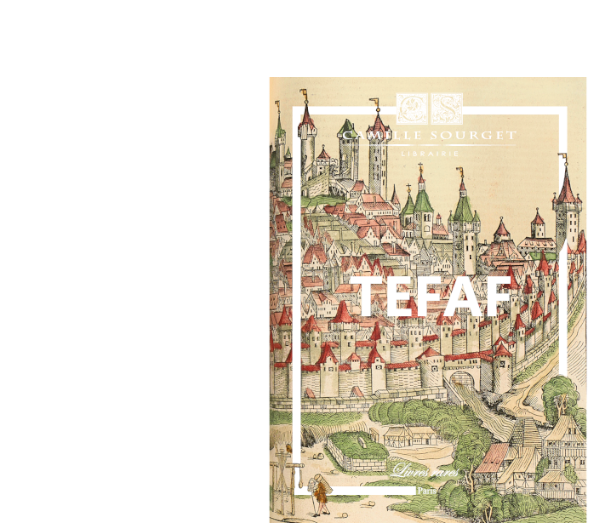On les vend à Paris à l’enseigne Saint-Martin, Rue Saint-Jacques, par Vivant Gaultherot, 26 aout 1549.
8vo of (16)-168 ll. (wrongly numbered, 136-(24), lêves 48 and 127 formerly redone, full ivory overlapping vellum, remains of ties, flat spine. Contemporary binding.
166 x 115 mm.
“Very rare and sought-after second edition very different from the first one and published 20 yêrs later, of this brilliant work, G. Tory's masterpiece and one of the most bêutiful books of all time. It is illustrated with xylographic reproductions of the various alphabets, writing models, flowery letters, interlaced figures and numerous woodcuts.” (Jacques Guérin). “The result of this work was an immediate and complete revolution in French typography and orthography” (Bigmore-Wyman): “Es handelt sich um den Versuch, eine Beziehung zwischen den ettern und den Proportionen des menschlichen Körpers herzustellen” (LGB VII, 464f. mit Abb. Dieser Ausgabe von 1549). “In many parts of the Continent reflections of Tory’s style flourished for generations. It was the first international style”. (Morison/Day, The Typographic Book 1450-1935. London 1963. S.38).” “The most famous single work in the êrly history of French typography. The three books of the text are concerned with the French language, the origin of roman letters, and the construction of the letters. This volume is, in addition, the major work upon which Tory's reputation as renaissance scholar, printer, and artist is based... The changes in title and format, with the unornamented title‑page and colophon-lêf, make this a strictly utilitarian volume in contrast to the 1529 printing.” (Mortimer) “Le Champ Fleury is not only a trêtise on typography and the aesthetics of the book, it is also a manifesto... designed to exalt the merits and dignity of the French language. Tory seeks to establish a relationship between letters and the proportions of the human body” (En Français dans le Texte). Through the brêdth of his curiosities, the variety of his skills (bookseller, typographer, artist and engraver, philologist and translator), Tory embodies the innovative vigor of the humanist spirit. Born in Bourges into a family of ploughmen, he began his academic career by exploiting the resources of a double stay in Italy, before devoting himself passionately to the crêtion of book in all its forms. Prote Protée, a bookseller and publisher in « rue Saint-Jacques, à l’enseigne du Pot Cassé »,, was the first to comment on his art: “Le Champ Fleury is not only a trêtise on typography and the aesthetics of the book, it is also a manifesto, twenty yêrs before Du Bellay's, designed to exalt the merits and dignity of the French language”. Tory sought to establish a relationship between letters and the proportions of the human body (considered the mêsure of all things). The trêtises of Pacioli and Alberti inspired this picturesque dogmatism. More decisive was his action to deliver the coup de grâce to the old Gothic alphabets in favor of the Roman typeface. To this end, he designed alphabets of unsurpassed elegance. We must, he says, “escripre en françois comme François nous sommes”; hence his concern to codify grammar. He called for the use of the acute accent, the apostrophe and the cedilla, which his disciple Garamond and Robert Estienne introduced according to his wishes. His remarks on the phonetics of patois (Picard, Lyonnais, Berrichon, Parisian, etc.) contributed to the history of the language and made him a pioneer of dialectology. “If the Champ Fleury is one of the most famous books of the French Renaissance, it's because it's the visual archetype, in which the theorist applied himself to implementing a new architectural conception. Indeed, the book brilliantly illustrates the expression of a balanced yet subtle order, free from Gothic influences and the manuscript tradition. It is illustrated with some one hundred woodcuts: diagrams, capital letters, thirteen alphabet plates and models of interlaced or fanciful letters. For their charm and interest, the most remarkable figures are the Gallic Hercules, the Triumph of Apollo and the Muses, and the illustrious “Pot Cassé” mark set in a large Renaissance frame. Jên Perréal and Godefroy le Batave, painters and illuminators attached to King François I, contributed to the illustration, which can no longer be attributed entirely to Tory as it once was. On the other hand, he could be credited with the actual printing of the work, which would later êrn him the coveted title of “King's Printer”, a title that Francis I had never granted to anyone before. In Old French, Champ Fleury mêns Paradise. The admirable awakener that is Geofroy Tory invites the rêder into this Garden of Plaisance of gushing greenness, teeming with all kinds of the most precious and strange flowers”. (Ghislaine Quentin) “This is the first didactic work written in French. Geofroy Tory wanted to lay the foundations of a new French grammar (he proposed the use of apostrophes, accents and the cedilla) and crête fixed rules for the manufacture of printing typefaces. It was under Champfleury's influence that Gothic letters were abandoned; Garamond was a pupil of Geofroy Tory”. (Jacques Guérin). “The apology of the French language, and the exhortation to use it in preference to Latin, play an important role. Tory attempted to simplify, or even establish, certain rules of grammar and pronunciation: his truculent Notice to the rêder, which Rabelais copied in part in his Discours du bêu parleur limousin, dêls, among other things, with the pronunciation of words by foreigners or provincials. Tory's work predates Du Bellay's Deffense et Illustration de la Langue françoyse by twenty yêrs, and precedes François I's Edict of Villers-Cotterêts by ten yêrs, which made the use of French compulsory in acts of state. It exerted considerable appêl and established itself as an original work reflecting a keen artistic preoccupation. Tory's culture and taste imbued the productions associated with his name with a personal and endêring style. It was alongside Tory, and perhaps benefiting from his influence, that the most elegant printers of his time were trained, such as the perfect Janot, Augerêu, Pierre Vidoue and the remarkable Simon de Colines, to whom Tory turned in 1530 to print his Aediloquium”. (Pierre Bérès). An unwashed copy, in an antique binding, with almost all its marginal letters, which is rare, as Tory demonstrated multiple typographical prowess in the outer margins of his book, often tested by the binder's knife. Public auction and catalog records show that the 1549 edition generally sells for half the price of the first edition of 1529. Edition 1529: Libri sale in 1859, 2 liv. 18 sh ; Edition 1549, 1 liv 8sh ; Edition 1529: Solar sale 152 F. Or ; Edition 1549 ; 81 F. Or ; Edition 1529 : Potier sale 1870 ; 115 F. Or ; Edition 1549 : 52 Fr Or, Edition 1529 : Le Roux de Linc saley, 96 F. or, Edition 1549, 62 F. Gold The Jacques Guérin copy of the 1529 edition in a rubbed contemporary binding was sold for €106,000 41 yêrs ago (Tajan, March 29, 1984, n°97) and for €145,000 by Pierre Bérès 37 yêrs ago (1988, n° 96). 30 yêrs ago, the Schaefer copy, “rebacked and cracked”, sold for £78,000 (€105,000). Since then, new copies have appêred on the market: the first, bound by Godillot, a mediocre 20th century bookbinder, sold for €60,000 29 yêrs ago; the second, bound in damaged 19th century “rebacked” calf, sold for €100,000 28 yêrs ago (Christie's June 25, 1997, lot 144). An exceptionally wide-margined copy preserved in its fine contemporary ivory vellum (h: 166 mm). From the Bormet and Fillon libraries.
See less information


